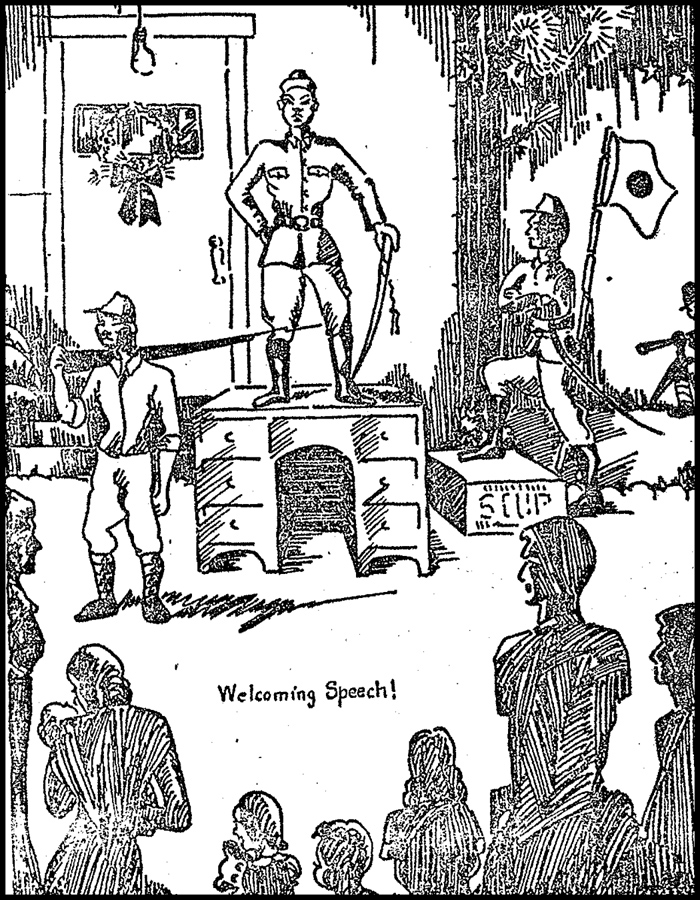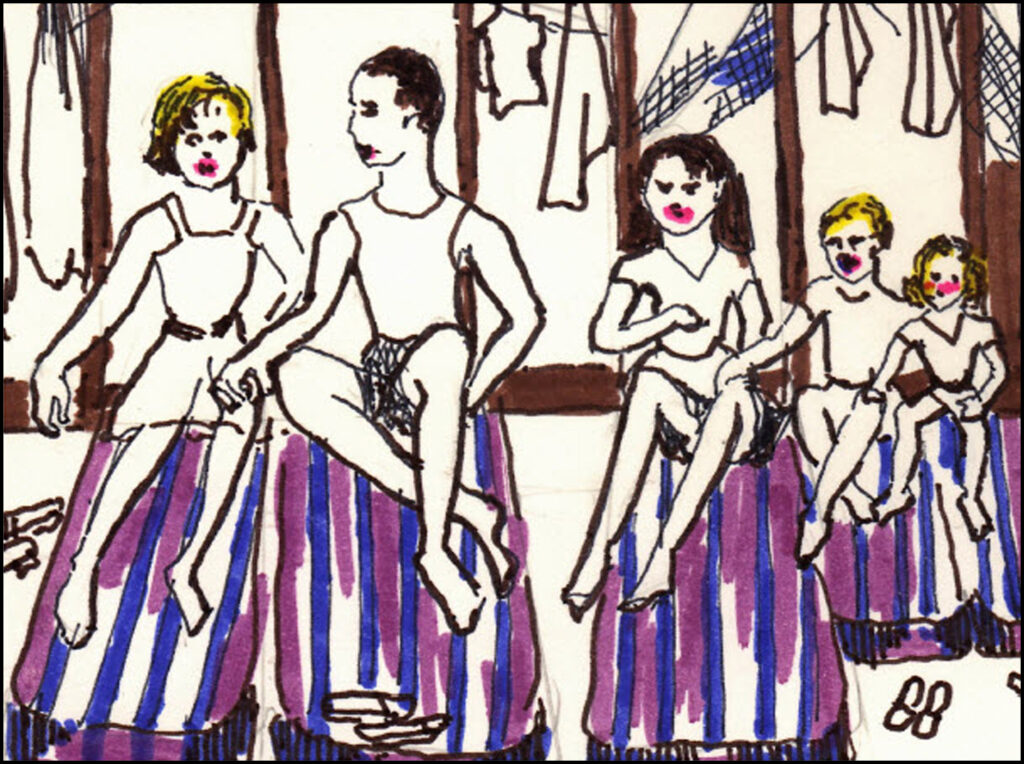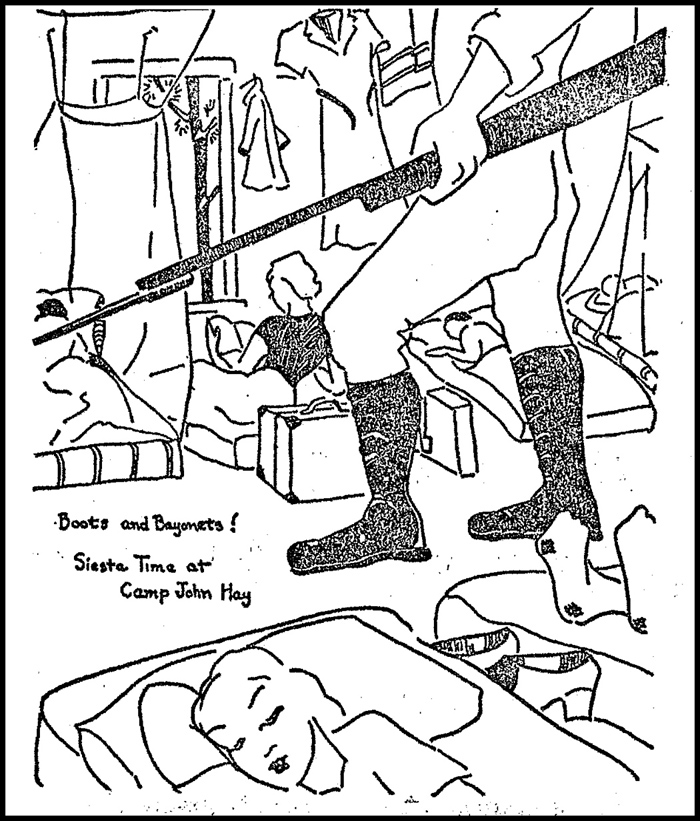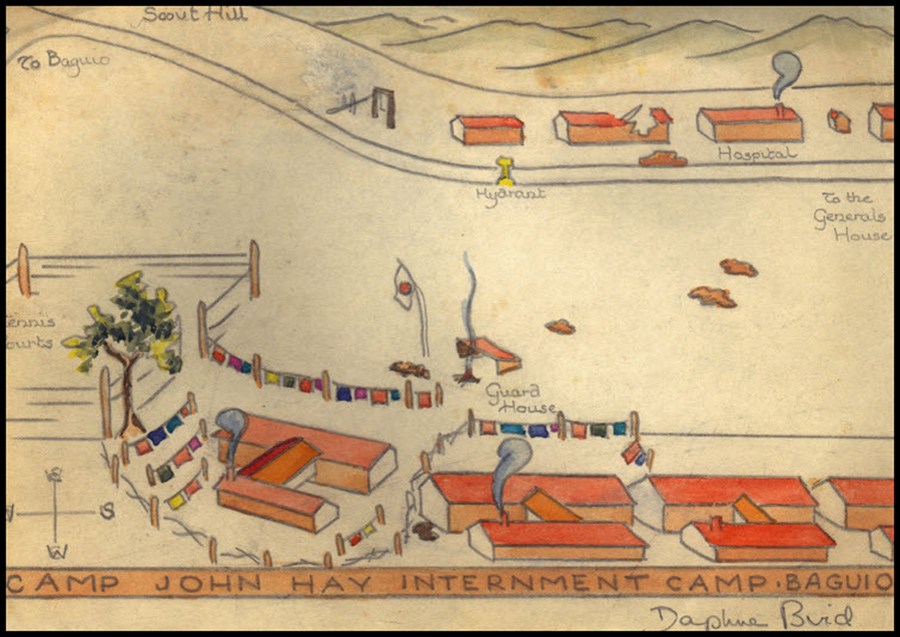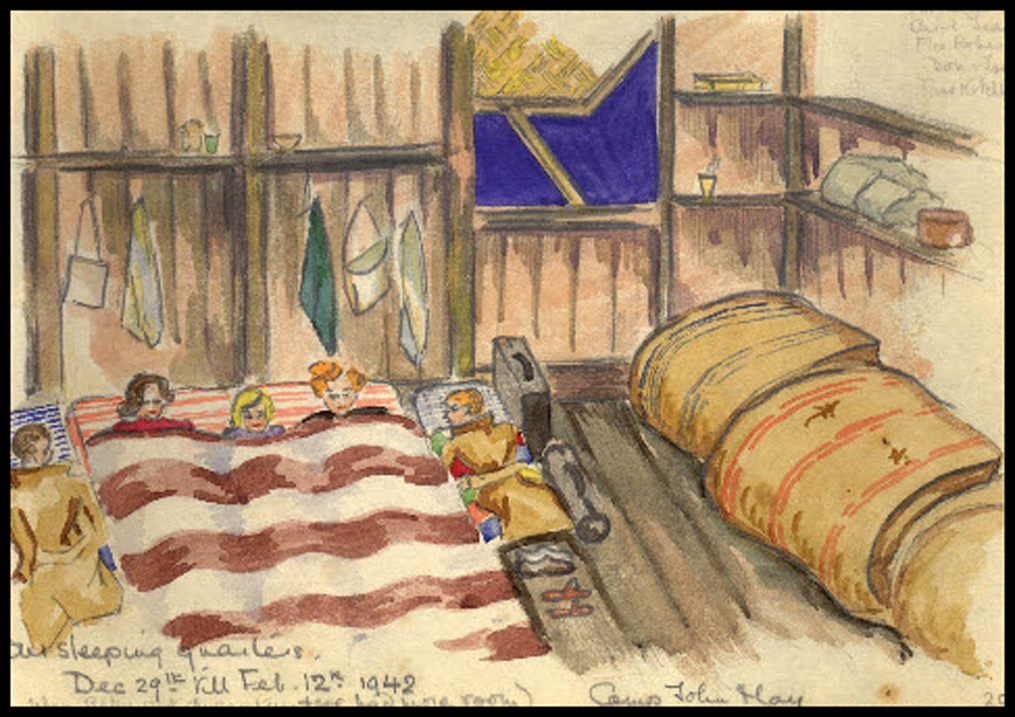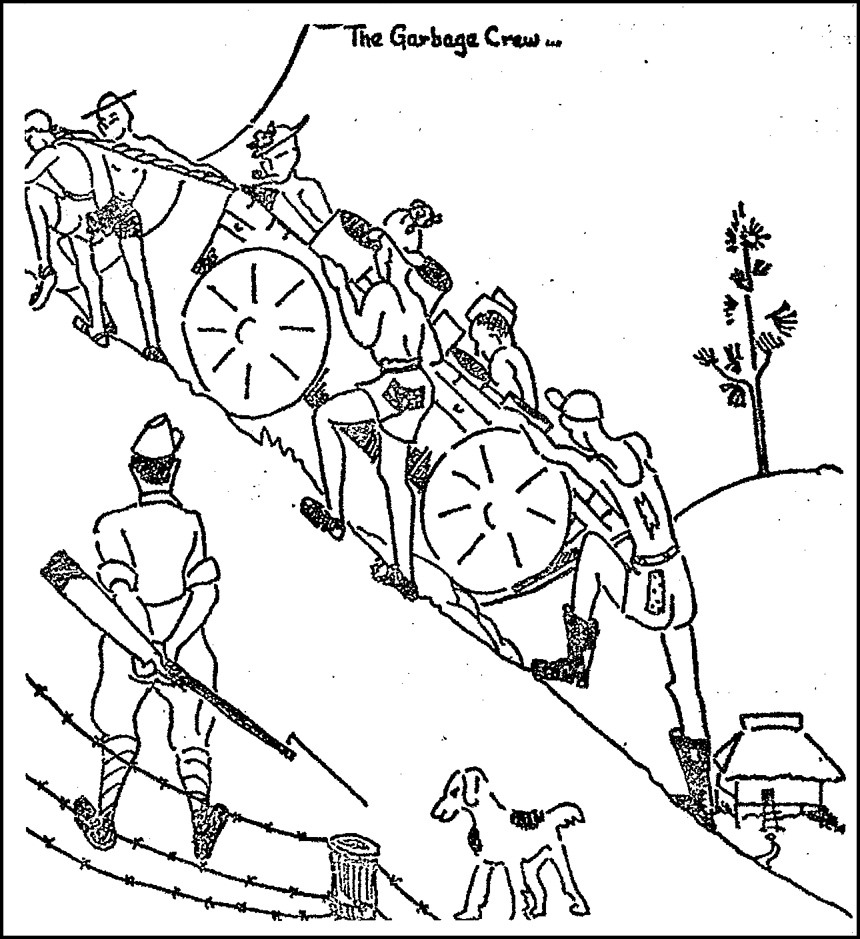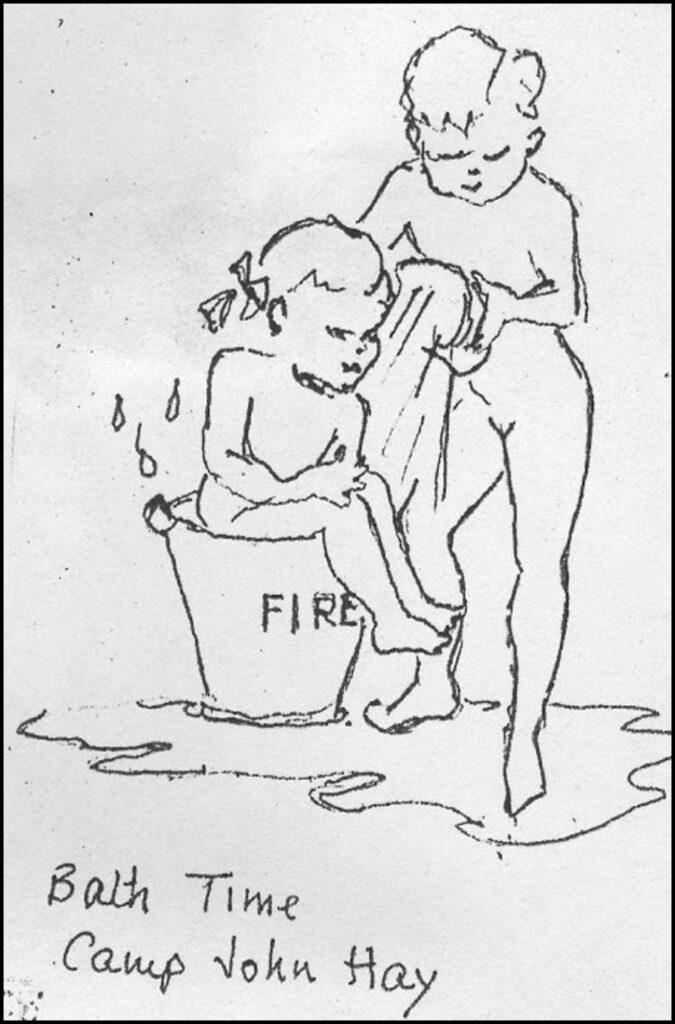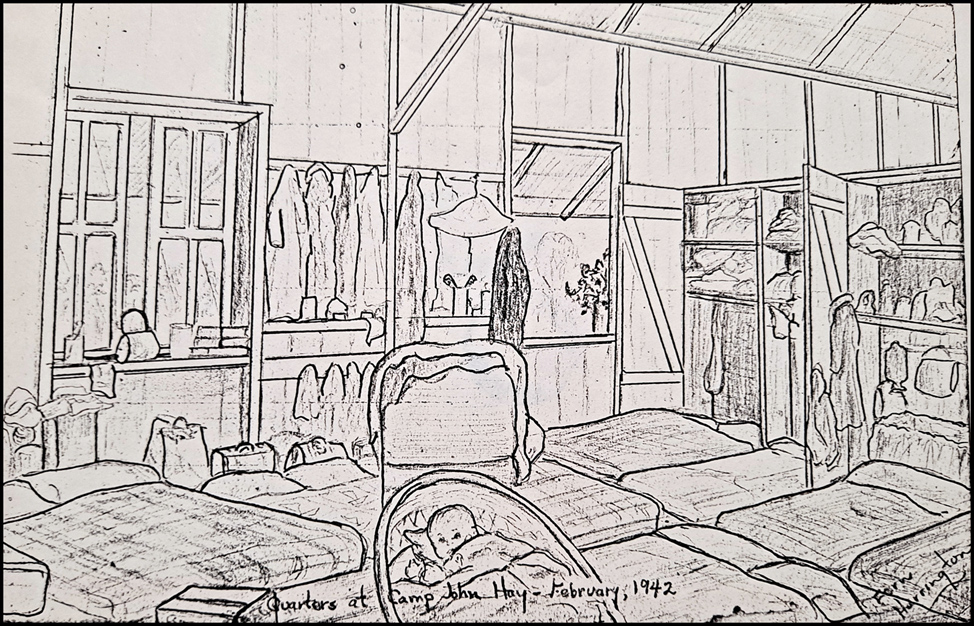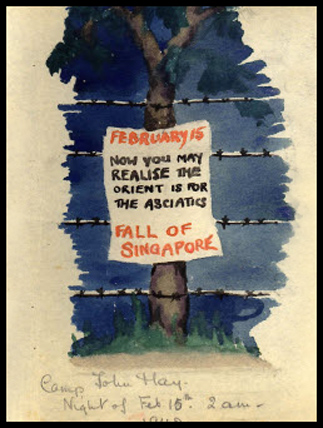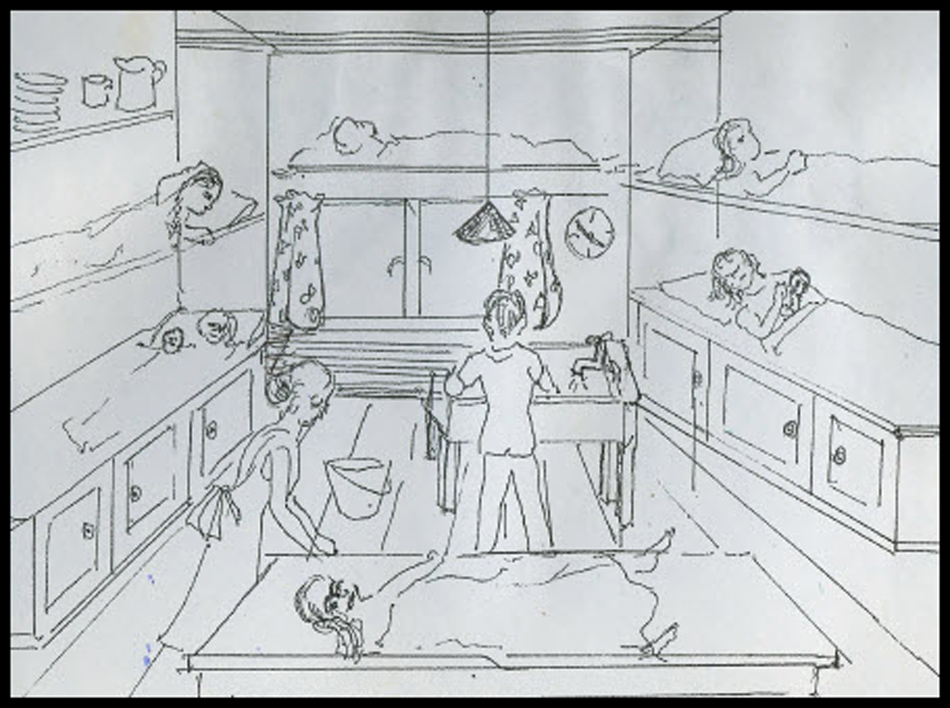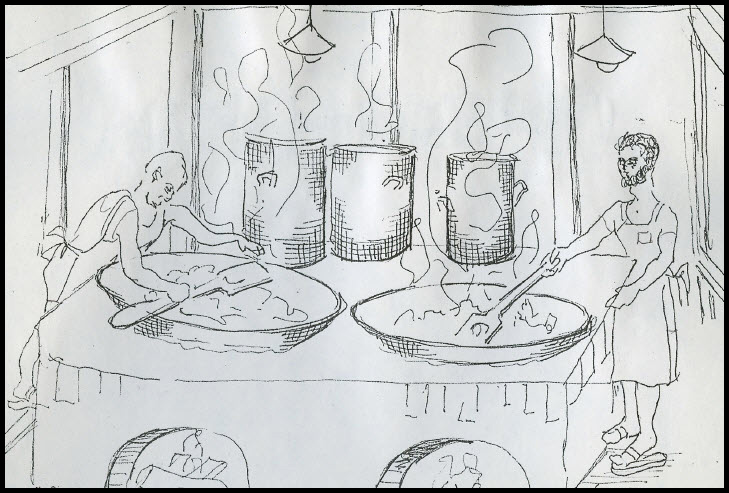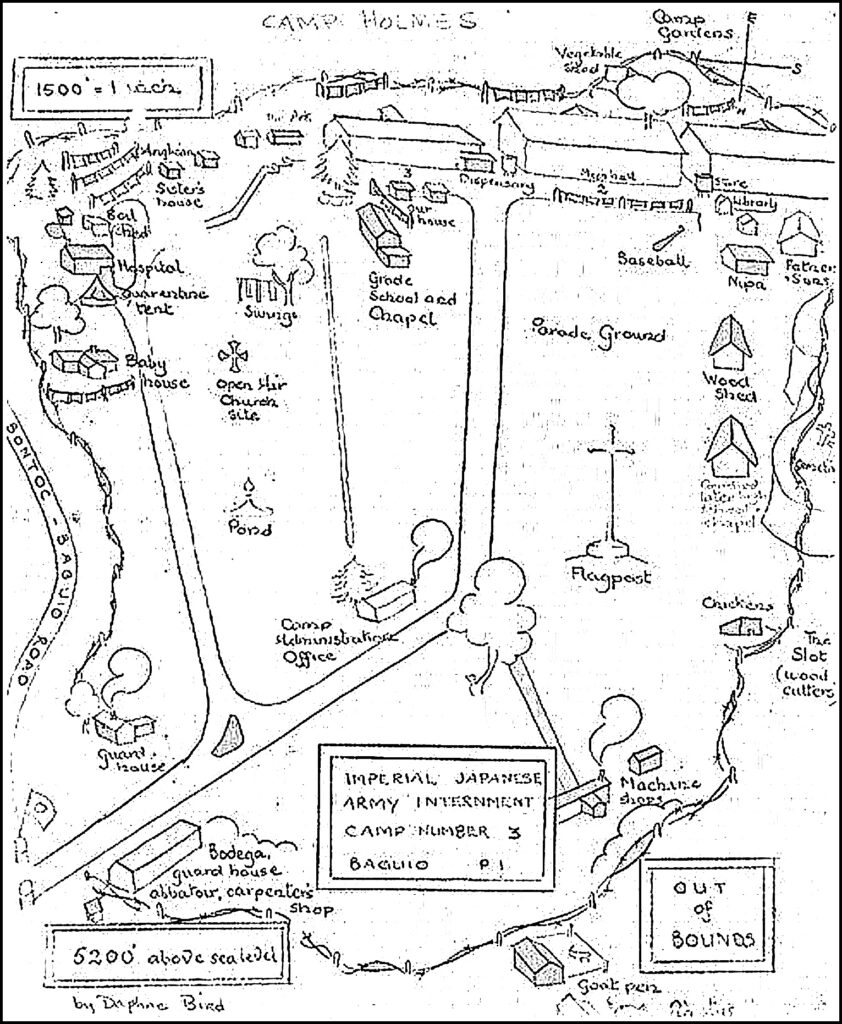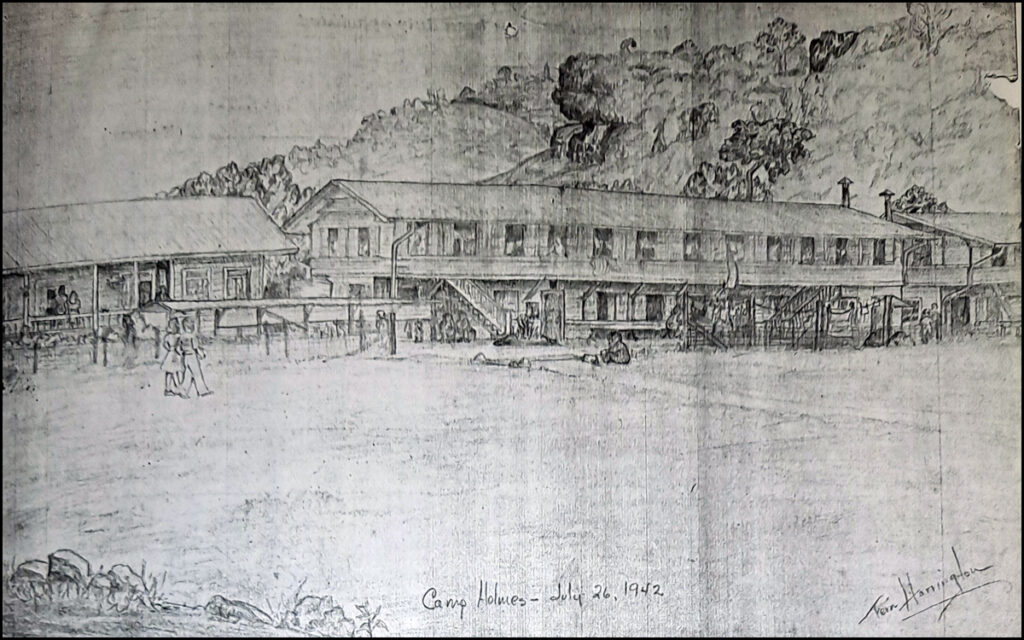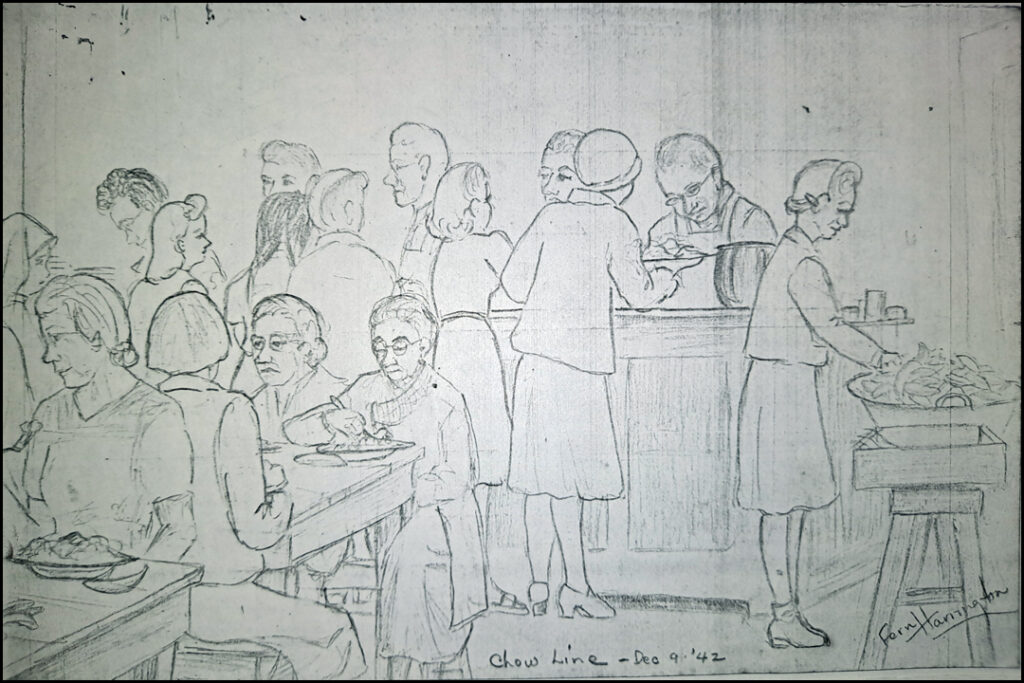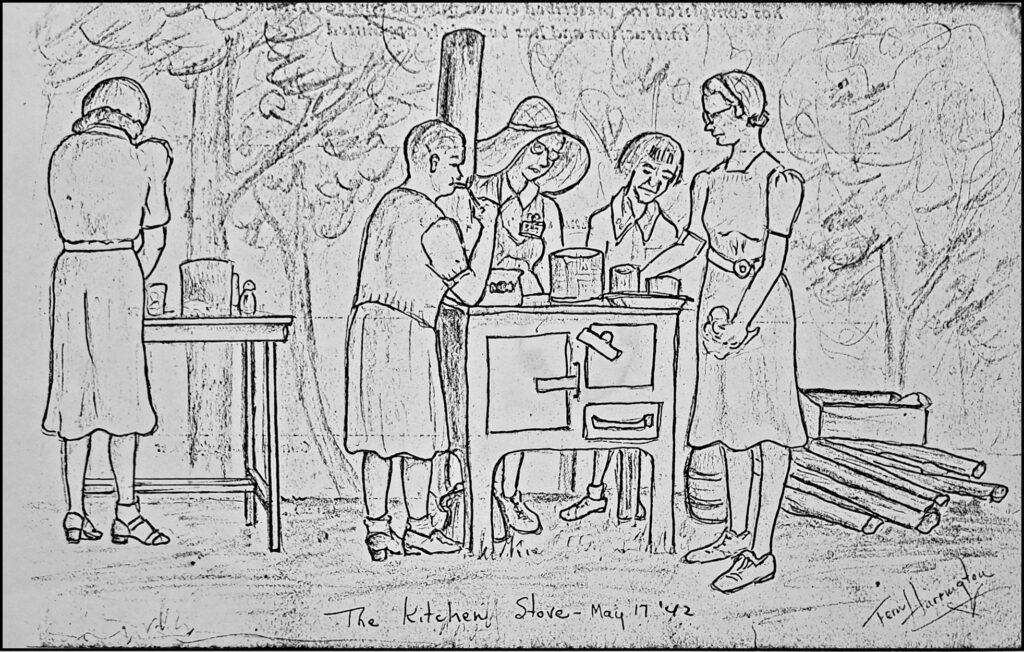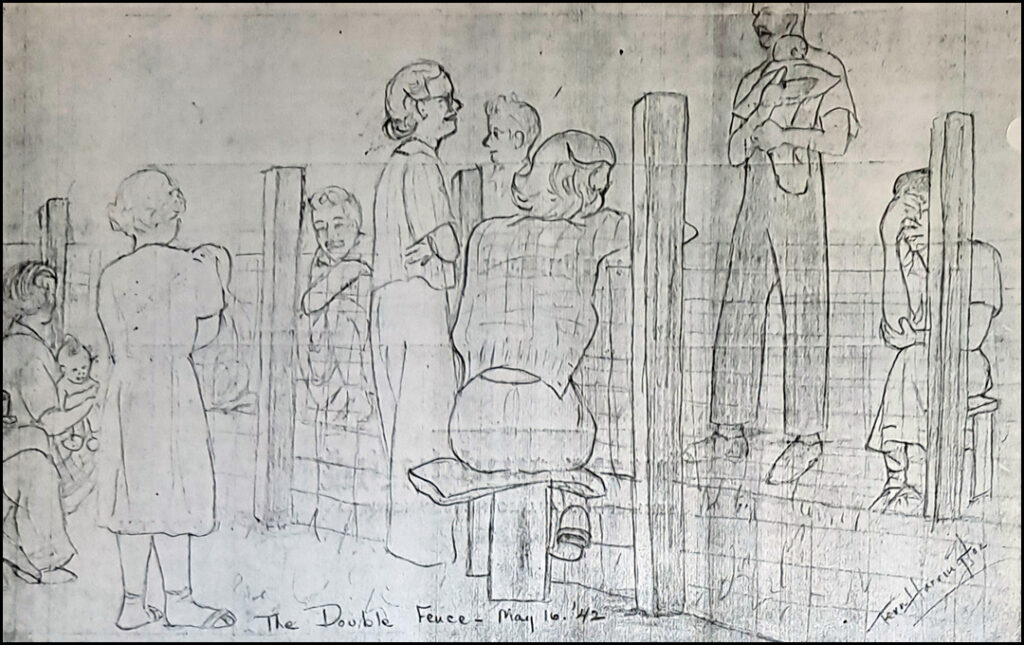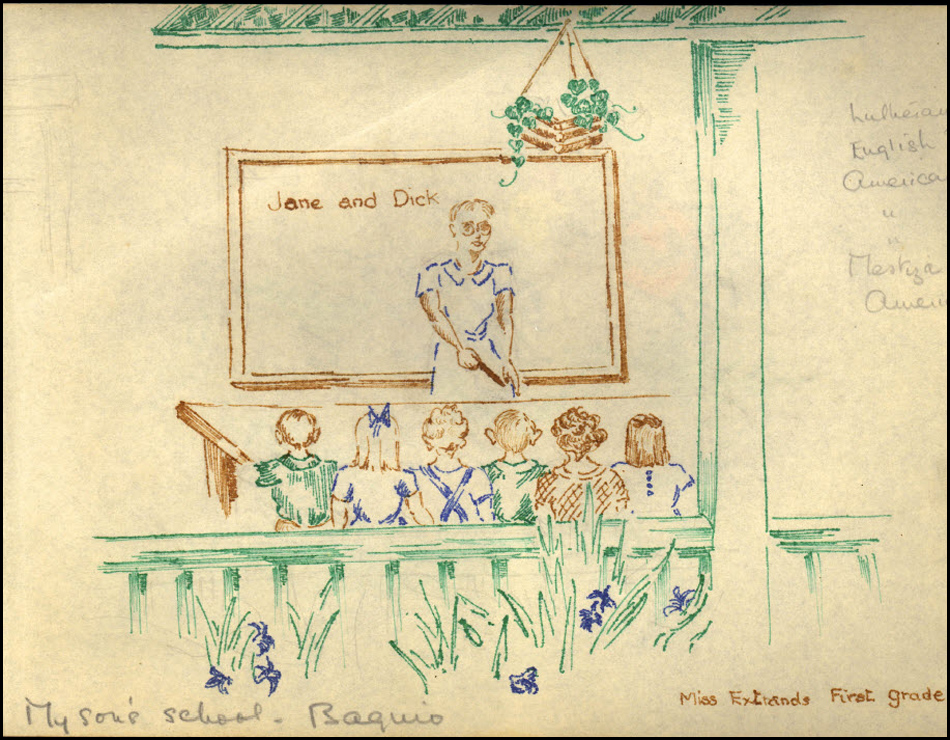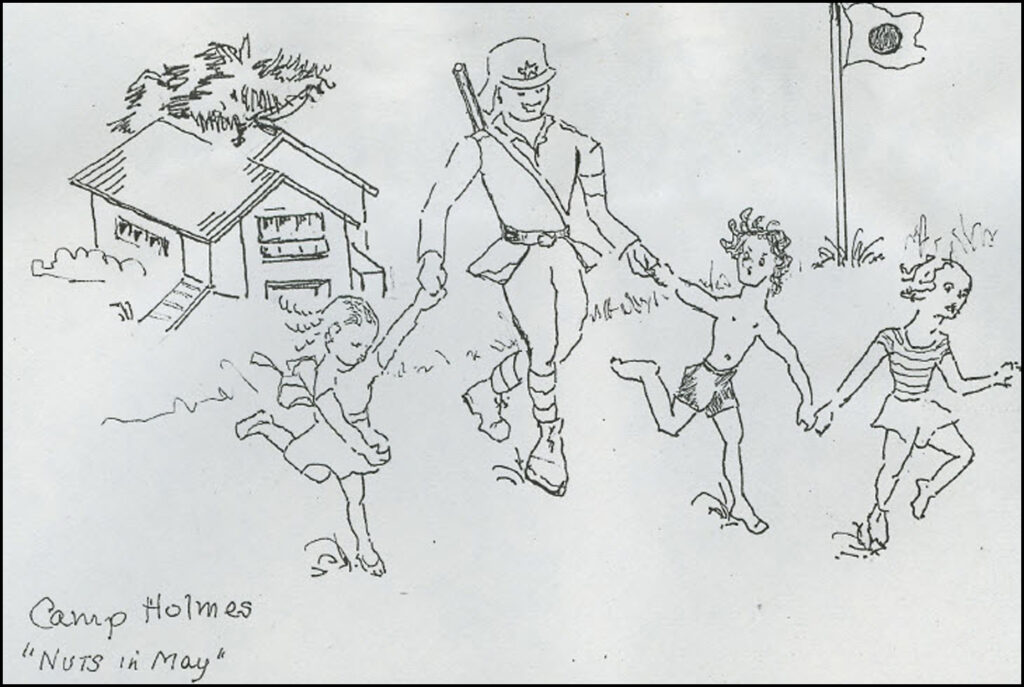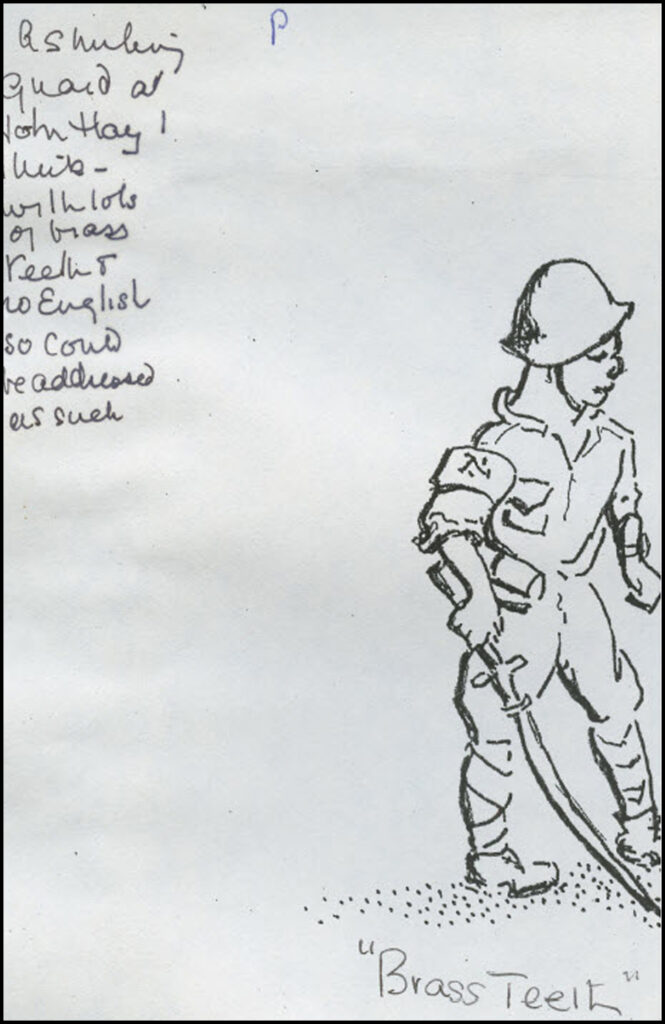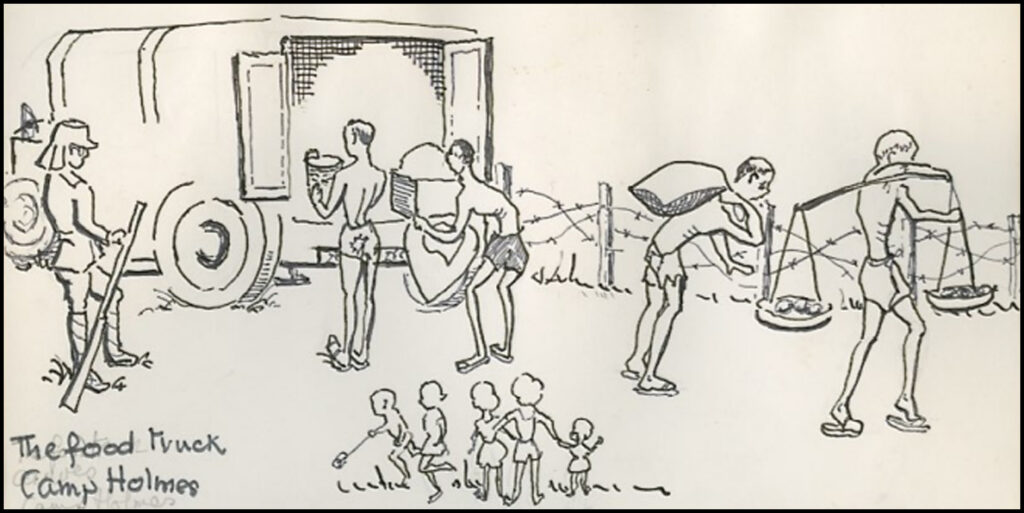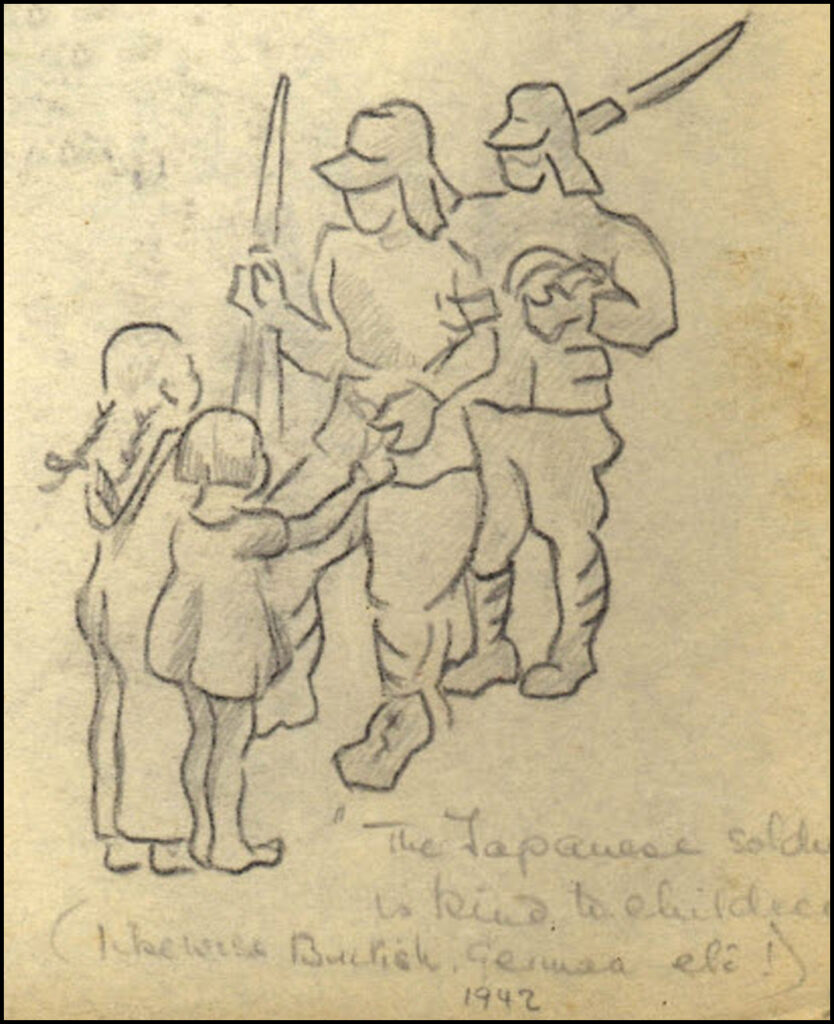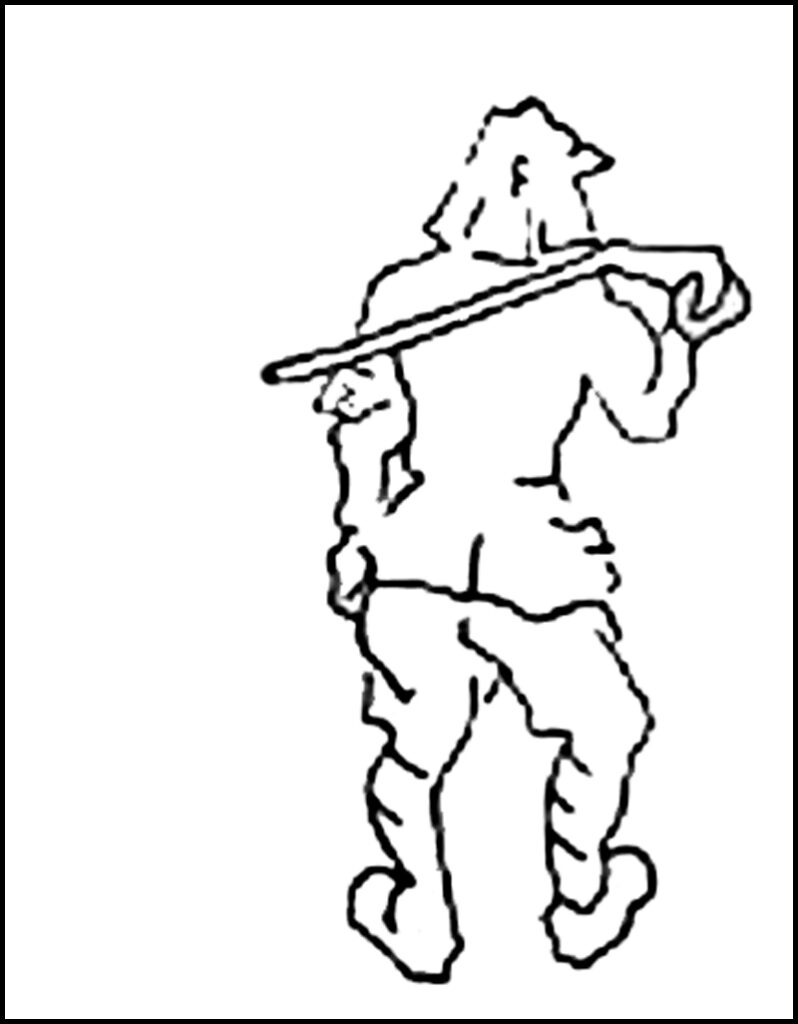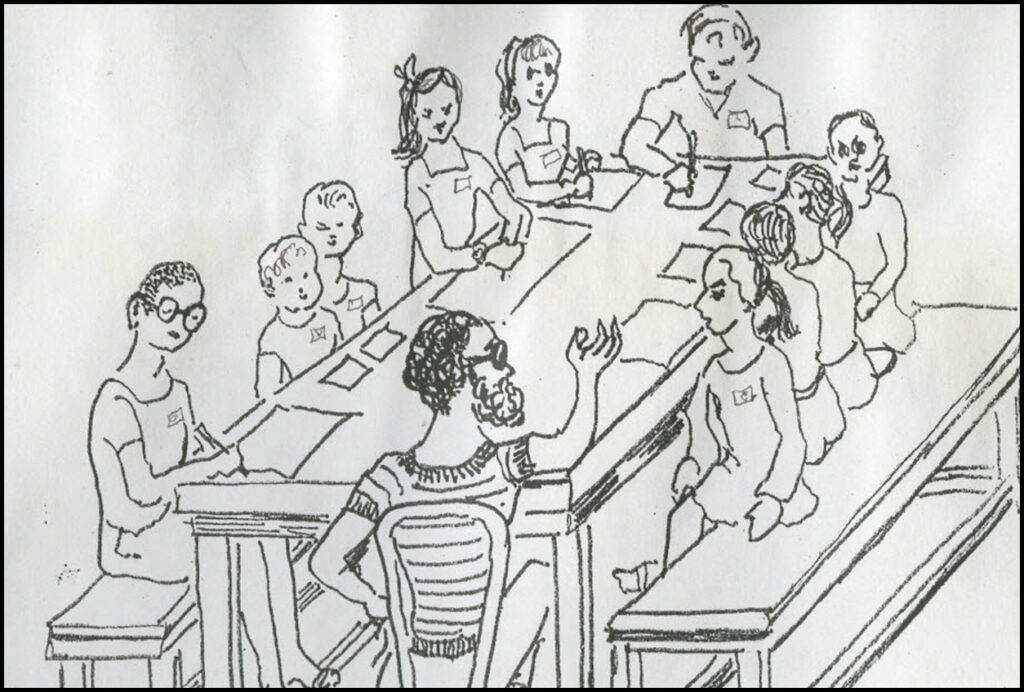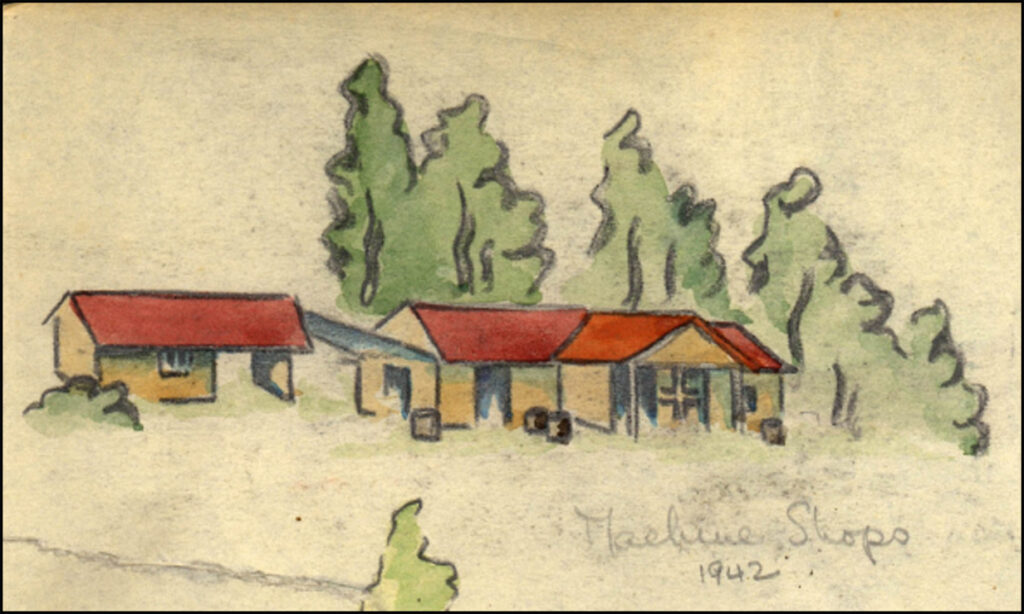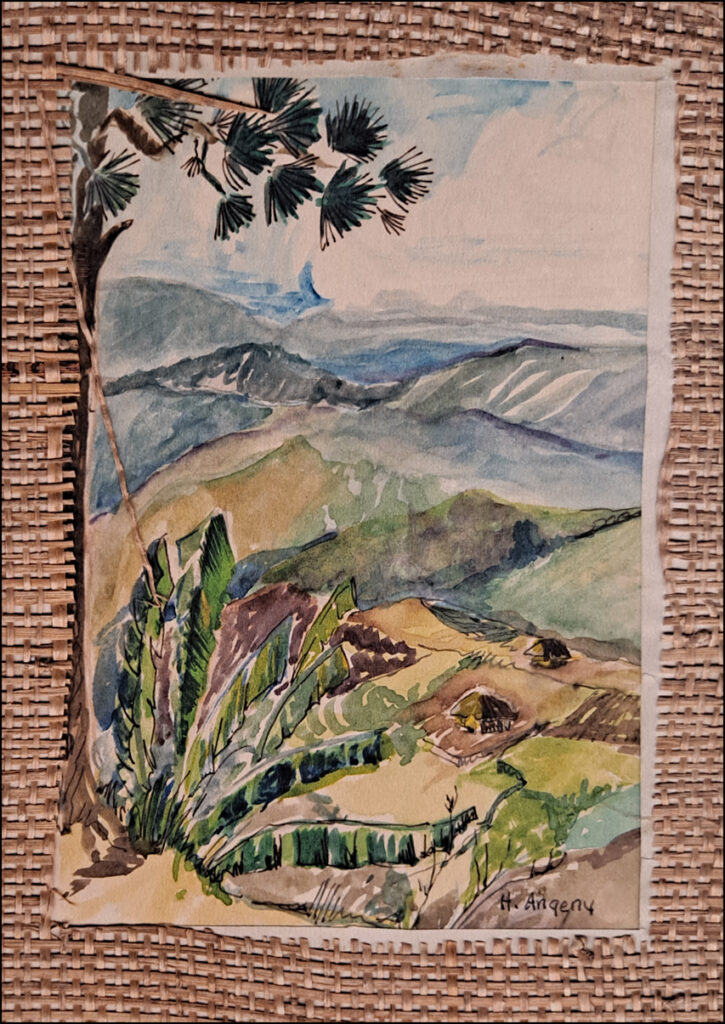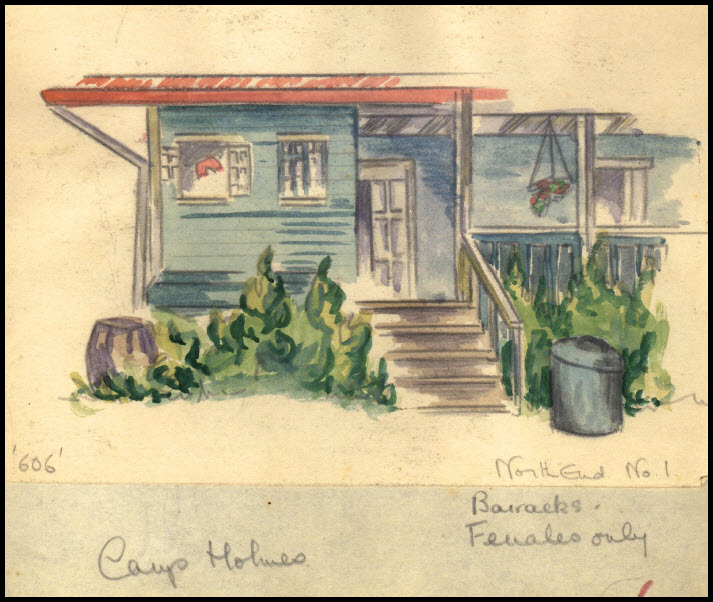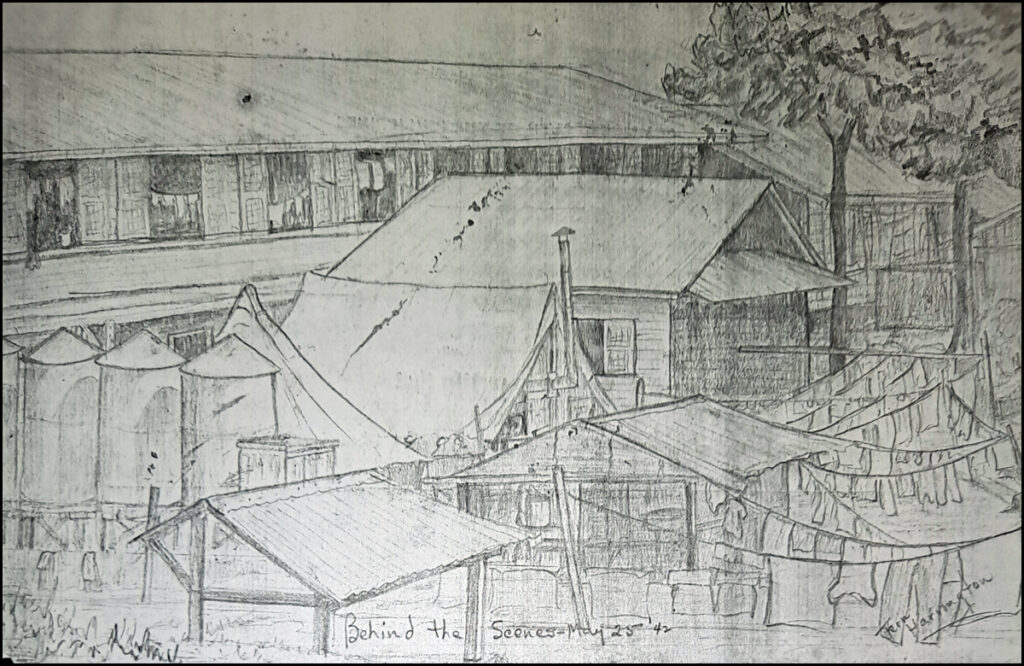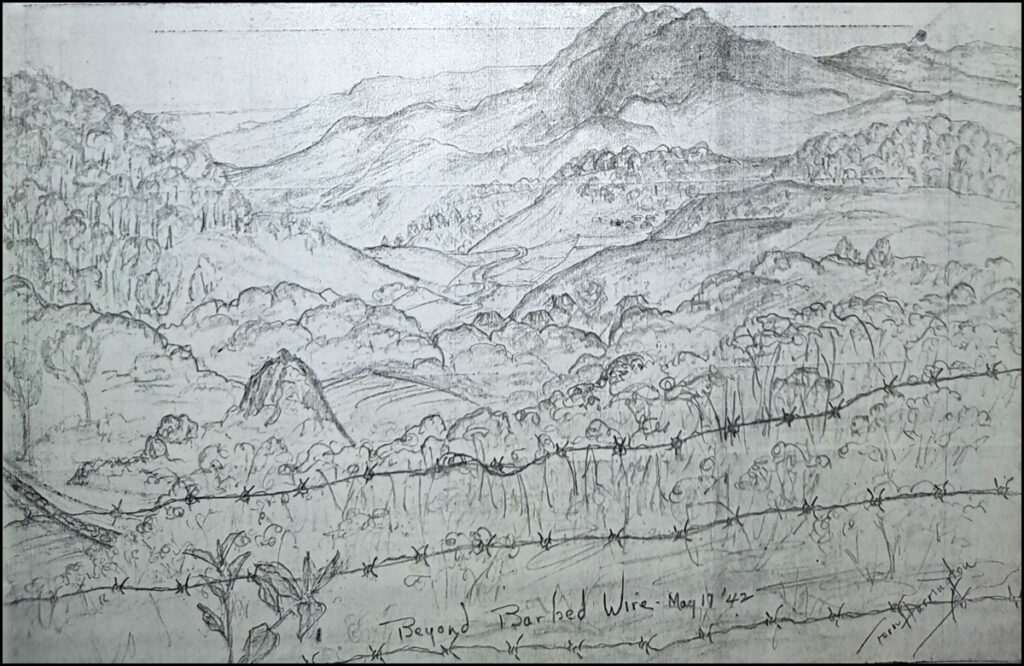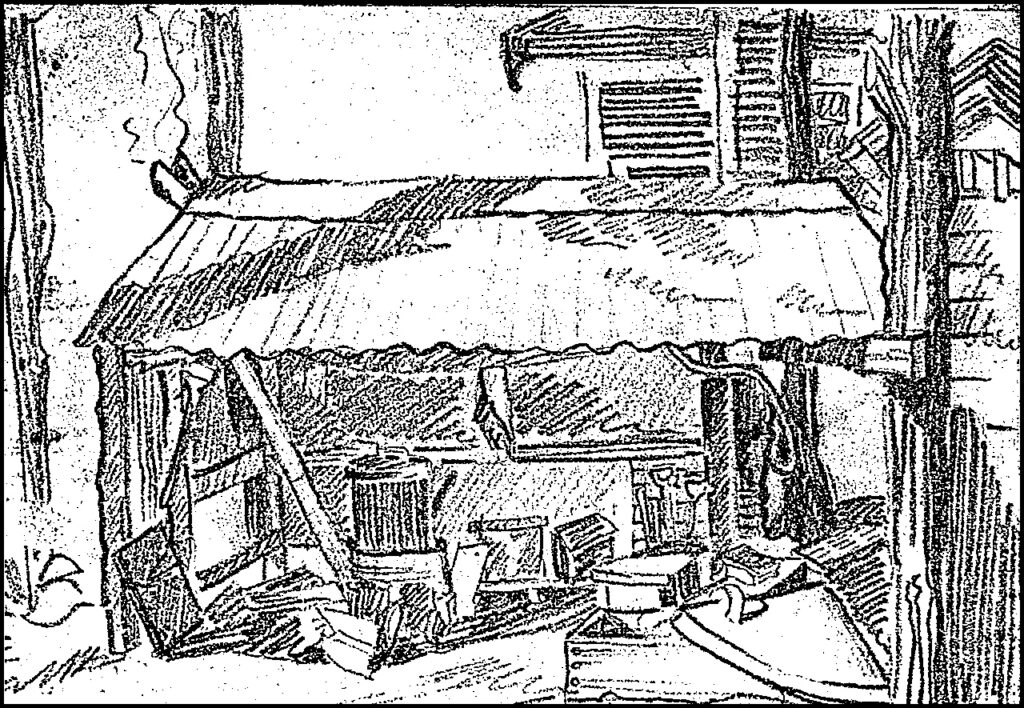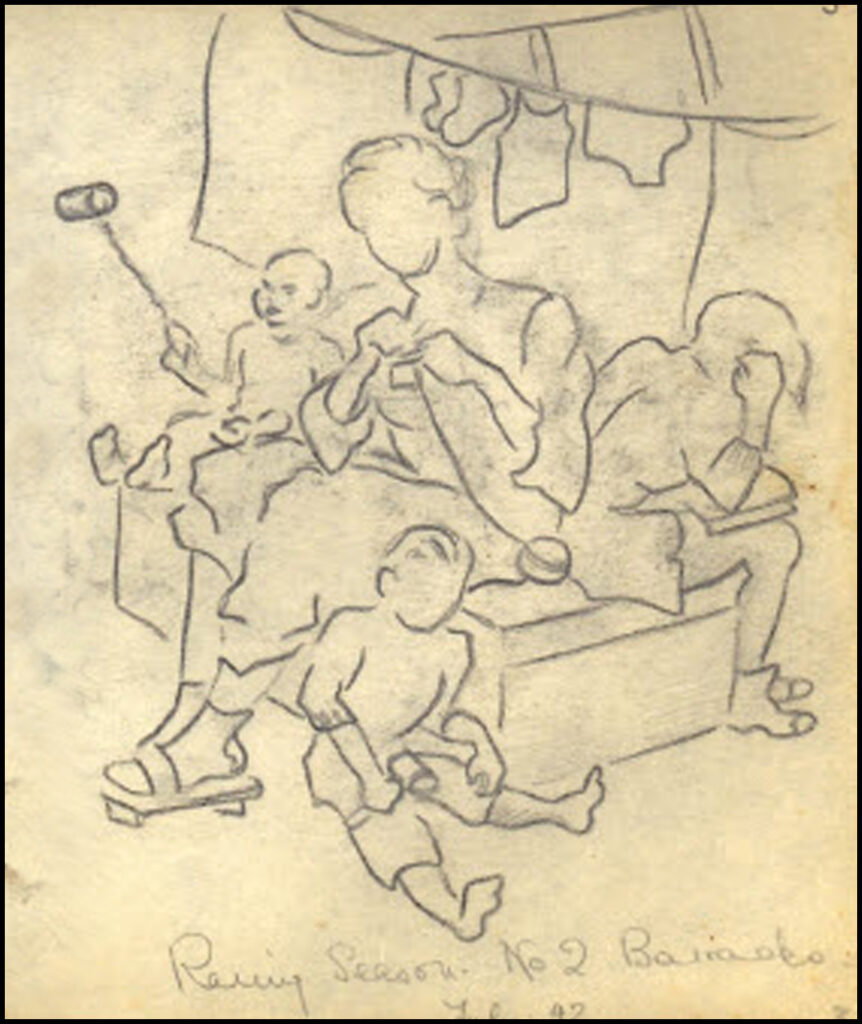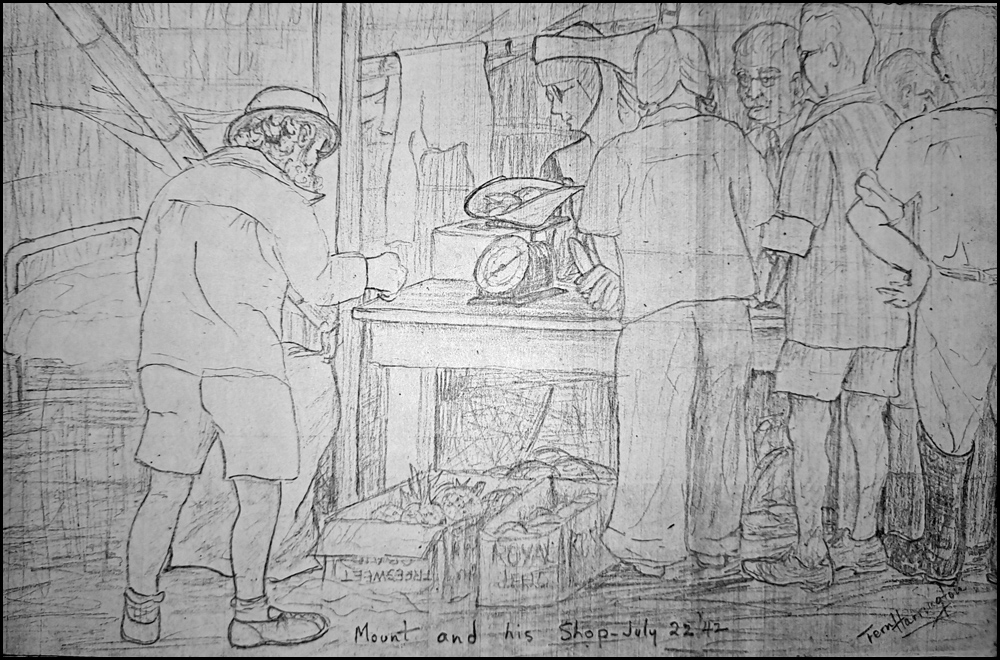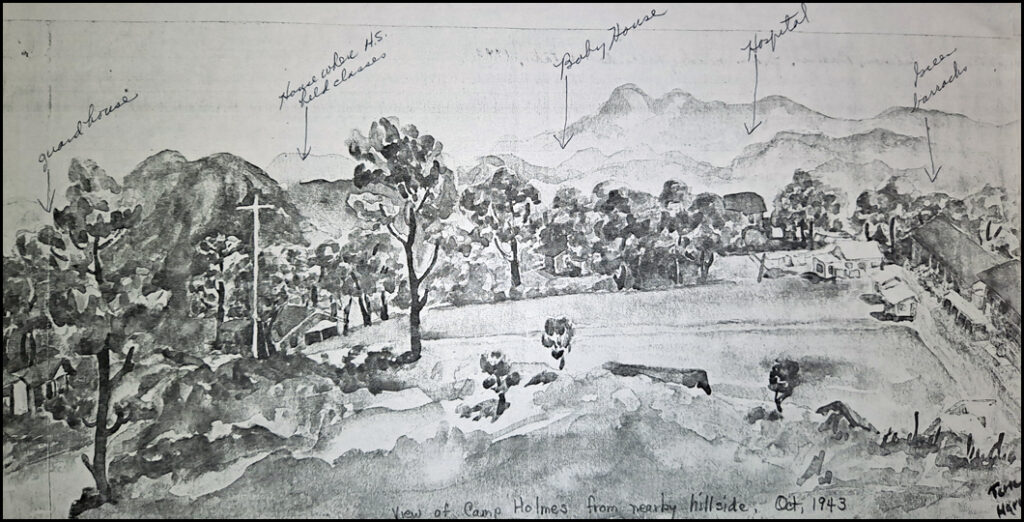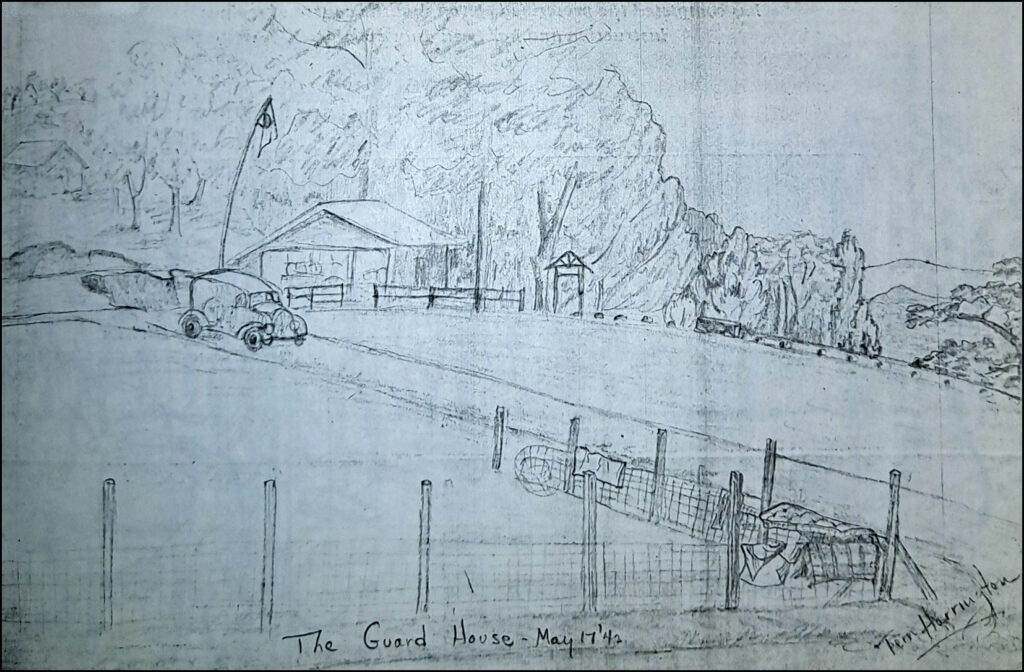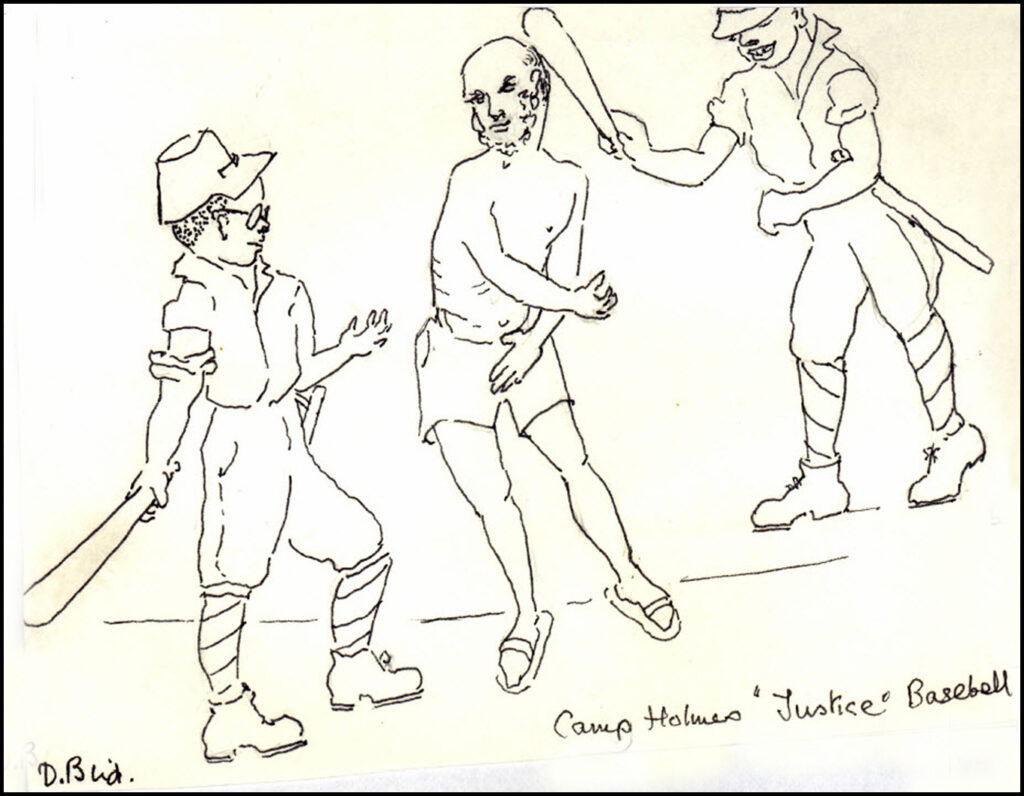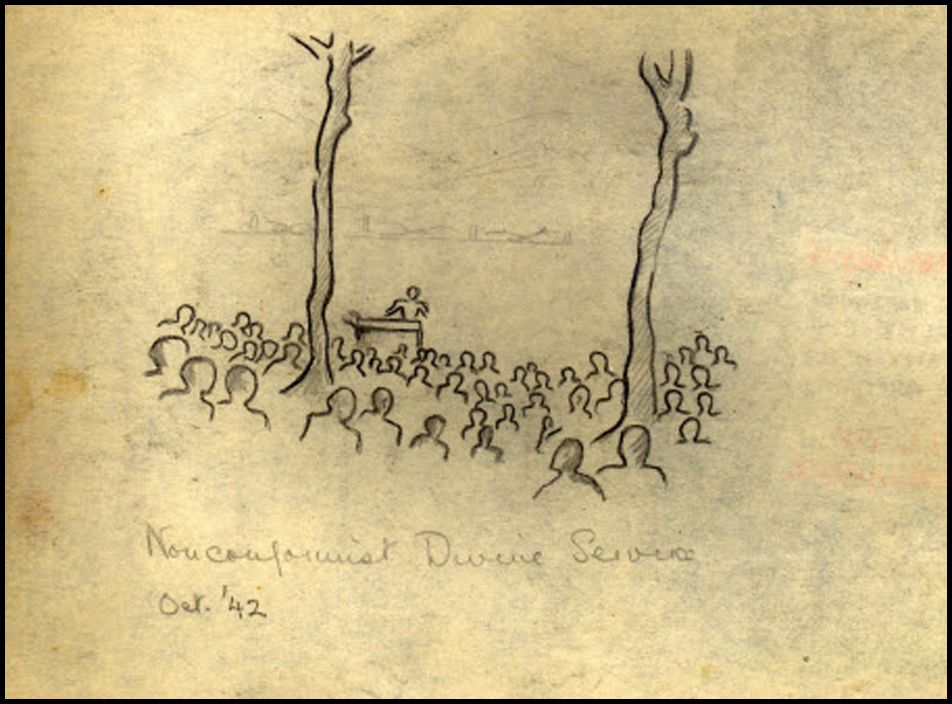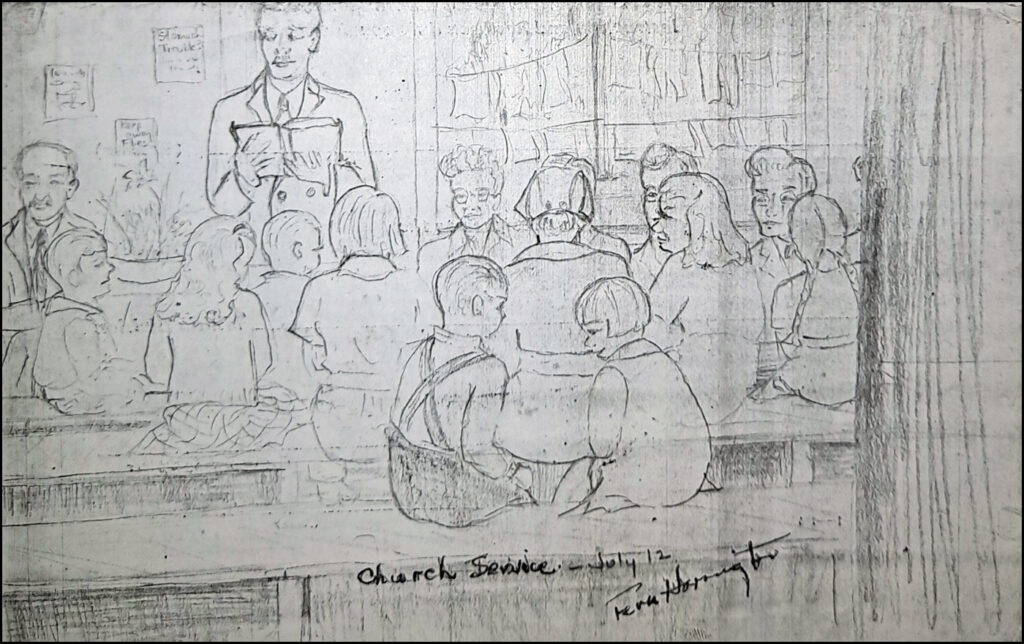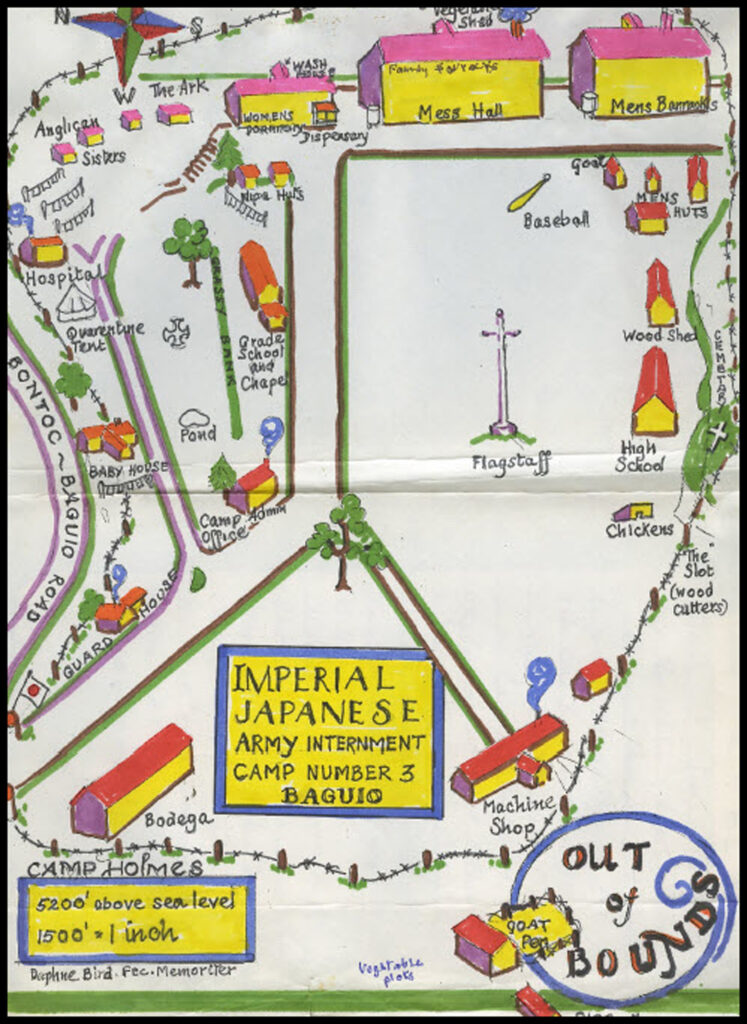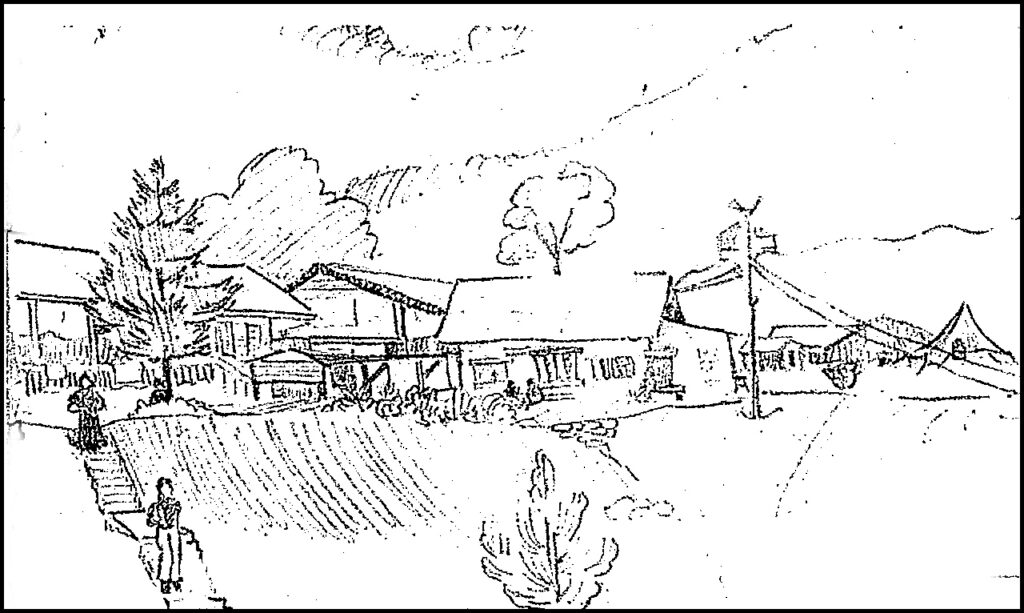Listen to Forbidden Diary
Season Two: 1942

The Complete Season 2
Binge all seven episodes of Season 2 without the recaps. Does not include epilogues.
1942 - Episode 7: High Crimes and Misdemeanors
Natalie and her family are interned in Camp John Hay. The Imperial Army appoints a local carpenter to camp commandant. Japanese soldiers and civilians steal from the prisoners. As hunger and dysentery spread through the camp, the internees find ways to survive.
NEW! Click See Pictures below to view sketches and paintings drawn by internees.
To read more about the artists, click on their pictures.
(Above) Sketch of Lt. Mukibo greeting new internees drawn by Helen Frances Buehl Angeny.
(Above) Drawn by Daphne Bird. She wrote, “Each adult had 34 inches to live in – less for children.”
(Above) First days in the barracks at Camp John Hay drawn by Helen Frances Buehl Angeny.
(Above) Map of Camp John Hay drawn by Daphne Bird.
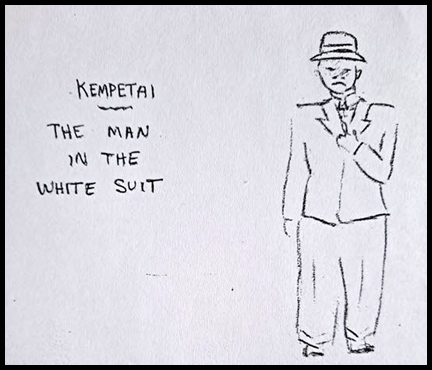
(Above) Drawn by Irene Miller Browning. Biography unavailable. Courtesy of the MacArthur Memorial.
(Above) Camp John Hay barracks painted by Daphne Bird who wrote that there was more room because her friend had dysentery. Notice the rolled-up mattresses on the right that Natalie mentioned in her diary.
(Above) Sketch of the garbage crew at work by Helen Frances Buehl Angeny.
(Above) Sketch by Daphne Bird.
1942 - Episode 8: Life Goes On
Babies are born in camp. Nida and Ismael persevere in Baguio under Japanese rule. The prisoners put on a show ending with surprise gifts from Nakamura. Interned missionaries are taken into Baguio for interrogation by the dreaded Kempeitai.
NEW! Click See Pictures below to view sketches, a painting, and the Camp newsletter.
To read more about the artists, click on their pictures.
(Above) Drawing by Helen Frances Buehl Angeny of Camp John Hay barracks.
(Above) Painting drawn by Daphne Bird of the post announcing that Singapore fell.
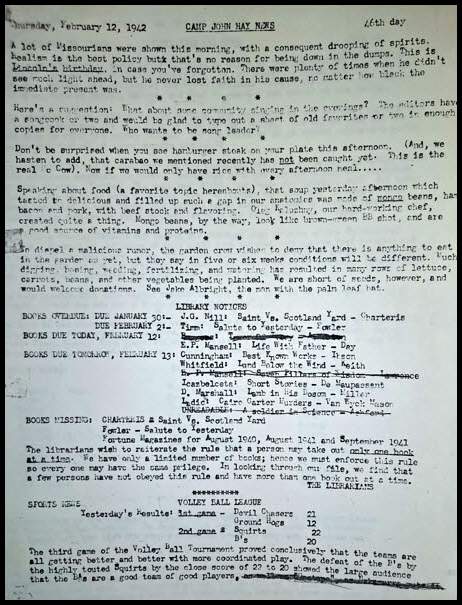
(Above) February 12, 1942 Edition of the Camp John Hay News. Courtesy of the MacArthur Memorial.
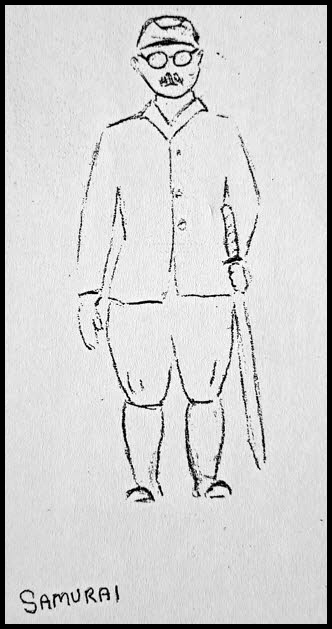
(Above) Sketch of one of the Imperial Army officers whom Natalie called “the big swords” drawn by Irene Miller Browning. Biography unavailable. Courtesy of the MacArthur Memorial.
(Above) Drawing of the maternity ward at Camp John Hay by Daphne Bird who wrote, “New Mums and babies had to sleep on the kitchen shelves in this house. Babies born on the table – a public performance!”
Episode 8 Epilogue: Interview with MacArthur Memorial Archivist
Jim Zobel, archivist at the General Douglas MacArthur Memorial, talks about the museum’s fascinating civilian POW artifacts. The MacArthur historian and author explains why Natalie believed that America was coming to the rescue and what was really happening–why MacArthur’s troops retreated to Bataan and MacArthur went to Corregidor. In this fascinating interview, Zobel also describes what life was like under Japanese occupation, how soldiers were treated in Japan’s military, and why Filipinos sided with America.
1942 - Episode 9: Home Sweet Holmes
Nakamura pontificates about American women, and the women make observations about him. All but one of the imprisoned missionaries are released. The Camp John Hay internees move to Camp Holmes. A Chinese internee is tortured.
NEW! Click See Pictures below to view sketches drawn by internees and Camp menus.
To read more about the artists, click on their pictures.
(Above) Drawing of Camp John Hay kitchen by Daphne Bird who wrote, “Internee cooks – one expert chef, two meals a day. Chief cook a Russian Chef Alex Kalusnev who did wonders with what materials he had. All vegetables prepared by women in a special room. Rice (raw) – picked over to clear out weevils.”
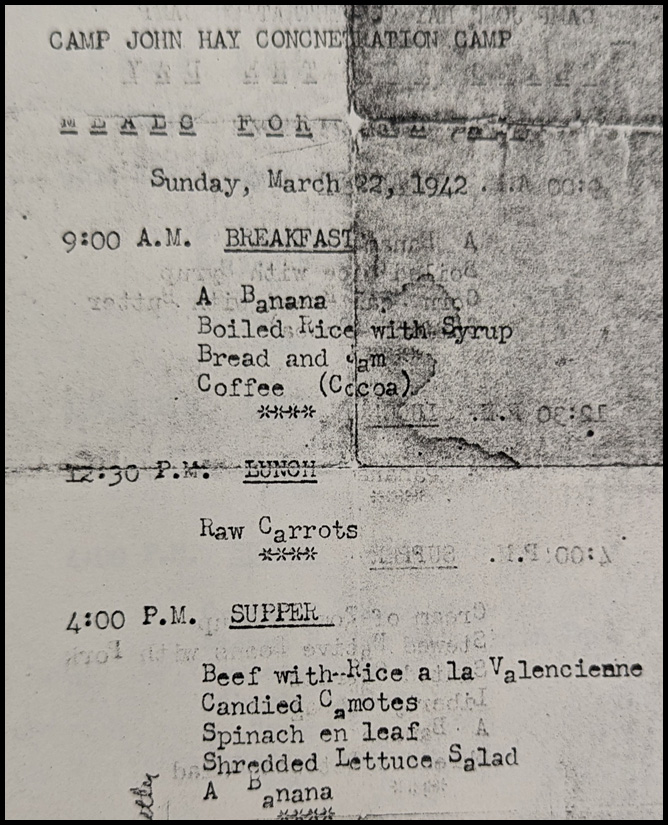
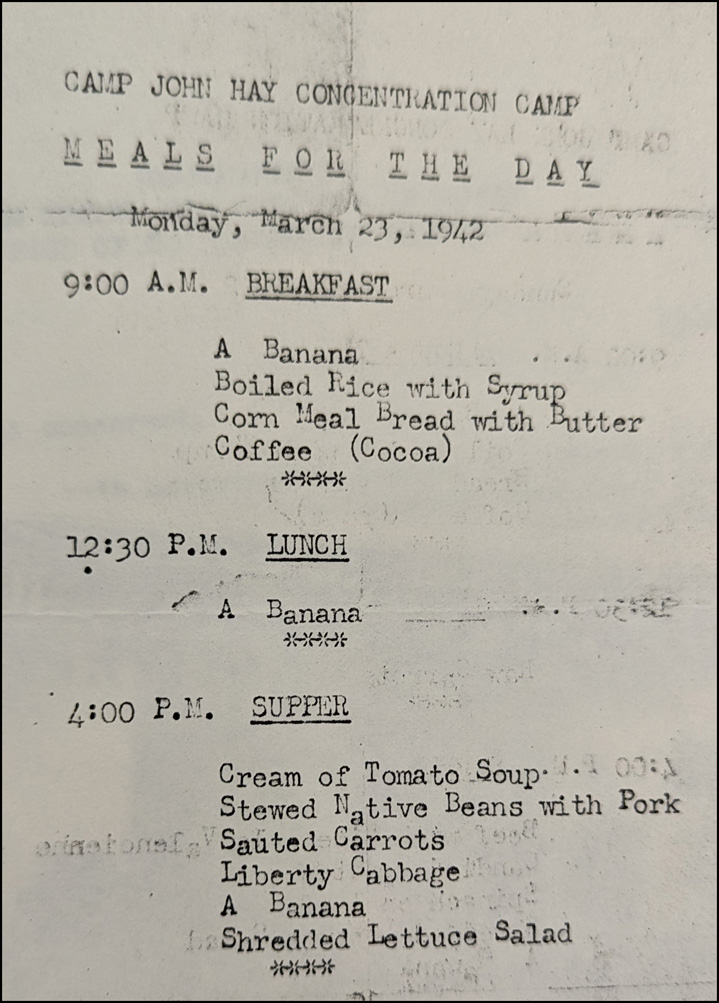
(Above) Chef Alex’s Camp John Hay Menus for March 1942. Courtesy of the MacArthur Memorial.
(Above) Map of Camp Holmes by Daphne Bird.
(Above) Sketch of Camp Holmes barracks by Fern Harrington Miles.
(Above) Sketch by Fern Harrington Miles of men serving women at Camp Holmes.
(Above) Sketch by Fern Harrington Miles of the women’s stove.
(Above) “The Double Fence” drawn by Fern Harrington Miles who wrote, “The [guards] put up two parallel fences six feet apart in front of the green barracks, and at the appointed hour, men lined up behind one fence and women, the other. The arrangement was so artificial that within a few weeks the fences were used only to sun musty bedding.”
1942 - Episode 10: Auld Lang Syne
Nida and Ismael offer the Crouters more help in addition to food their deliveries. The prisoners get to know the guards who cycle through the camp. A secret radio is installed in the camp hospital. June addresses camp inequities among prisoners. Nakamura gives the prisoners parting gifts.
NEW! Click See Pictures below to view sketches drawn by internees and memorabilia.
To read more about the artists, click on their pictures.
(Above) Sketch by Daphne Bird of her son’s school.
(Above) Sketch by Daphne Bird of Japanese soldier and Camp children.
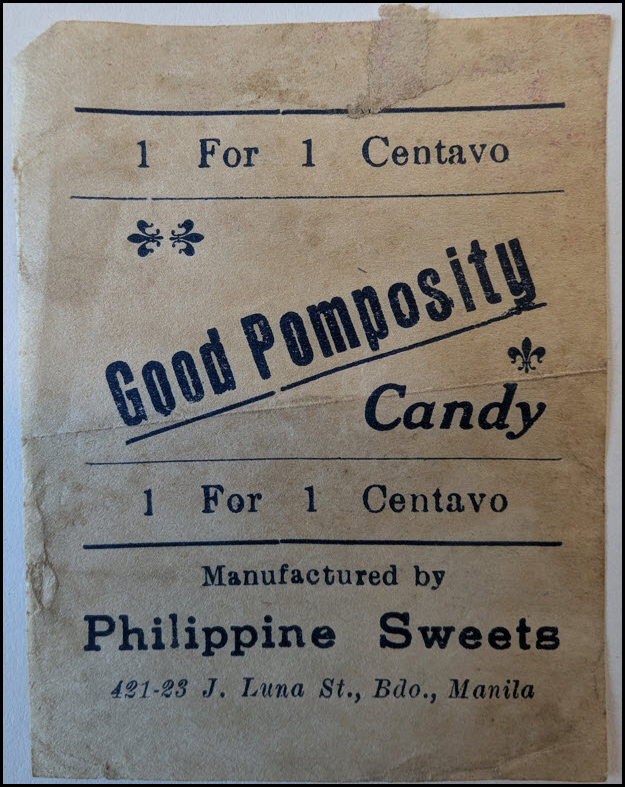
(Above) Wrapper for candy Natalie wrote about Lt. Mukibo giving Camp children. Courtesy of the Crouter Family and the Schlesinger Library.
(Above) Sketch by drawn by Daphne Bird at Camp John Hay of a Japanese soldier who was transferred to another post in Episode 10.
(Above) Sketch by Daphne Bird. In her description, she wrote, “Daily excitement. Arrival of the food truck from Baguio.”
(Above) Sketch by Daphne Bird who wrote, “The Japanese soldier is kind to children.”
(Above) Sketch of Japanese soldier by Daphne Bird.
1942 - Episode 11: Close Calls
As typhoon season begins Jerry is brought in for questioning. Nida and Ismael talk about guerrilla insurgencies. Natalie gets a tour of the camp’s shop, a special gift, and called to the guard house.
NEW! Click See Pictures below to view paintings drawn by internees.
To read more about the artists, click on their pictures.
(Above) Sketch by Daphne Bird. In her description, she wrote, “Dr. Skerl (London University) teaching, later abandoned as children could not learn on inadequate diet. Skerl made ink out of cinders and was well above average in skills and energy.”
(Above) Painting by Daphne Bird of the Camp’s machine shops.
(Above) View from Camp Holmes of Lingayen Gulf painted by Helen Frances Buehl Angeny.
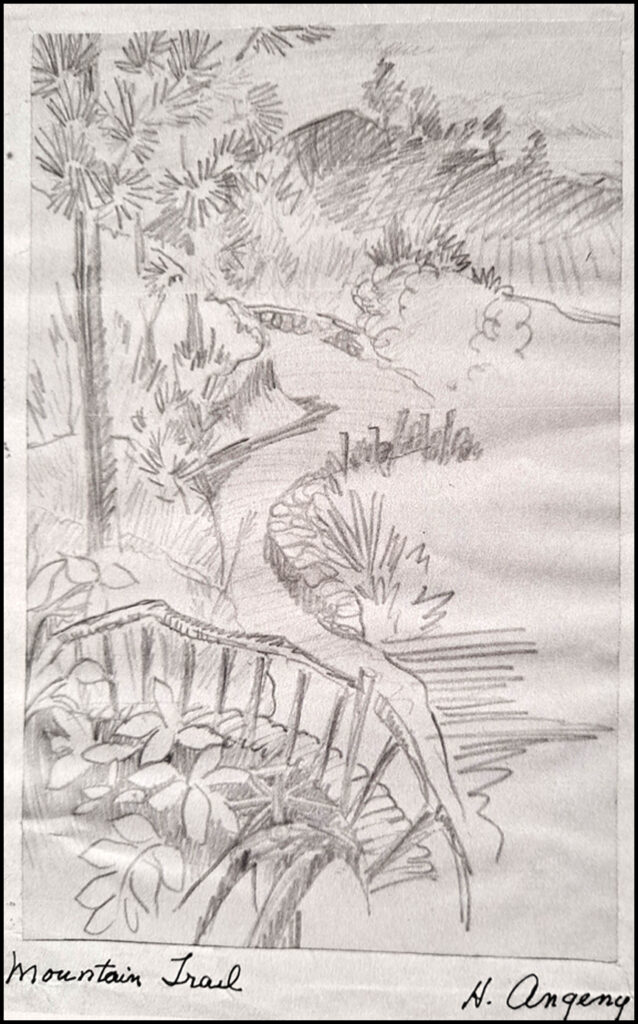
(Above) Sketch of mountain trail near Camp Holmes by Helen Buehl Angeny.
(Above) Picture by Daphne Bird of the north side of the women’s barracks.
(Above) Sketch by Fern Harrington Miles of view behind the Camp Holmes barracks.
(Above) Sketch by Fern Harington Miles of the mountain vista and barbed wire surrounding Camp Holmes.
1942 - Episode 12: Lovers and Guerrillas
Bullets fly around Baguio and Camp Holmes as Filipino and Igorot guerrillas attack the Japanese. Natalie worries about Jerry’s depression. Additional co-mingling restrictions increase sexual tensions.
NEW! Click See Pictures below to view sketches.
To read more about the artists, click on their pictures.
(Above) Sketch by Helen Frances Buehl Angeny of the sterilization shed for the Camp’s hospital.
(Above) “Rainy Season No. 2 Barracks” by Daphne Bird.
(Above) Sketch by Fern Harrington Miles who wrote, “In July 1942 an internee ordered food through Filipino friends and resold it at a profit to internees who had no source of extra food. This led to a nonprofit camp store.”
(Above) Full view of Camp Holmes by Fern Harrington Miles.
(Above) Sketch of Camp Holmes guard house by Fern Harrington Miles.
1942 - Episode 13: Better and Lesser Angels
The holidays are celebrated in bittersweet, internment style. True friends come through for Natalie. A little boy teaches the Camp a lesson. Dysentery returns, and Dr. Hall is not sure how the internees will survive 1943.
NEW! Click See Pictures below to view sketches.
To read more about the artists, click on their pictures.
(Above) Sketch by Daphne Bird of guards beating prisoner with baseball bat.
(Above) Sketch by Daphne Bird of a church service at Camp Holmes.
(Above) Sketch by Fern Harrington Miles of a church service. Lynn Z. Bloom who edited the book, Forbidden Diary, wrote in the Introduction that there were “twenty-two sects” in Camp.
(Above) Map of Camp Holmes by Daphne Bird.
(Above) Sketch by Helen Buehl Angeny of Camp Holmes.
Episode 13 Epilogue: Interview with MacArthur Memorial Archivist
In this last interview, Jim Zobel shares fascinating insights about MacArthur’s first steps to liberate the Philippines— from the campaign in Papua New Guinea to making early radio contact with guerrillas in the Philippines. Zobel shares true, but unbelievable stories about guerrilla heroes and discusses the brutal Kempeitai, Imperial Japan’s military police. Larger-than-life stories, fascinating WWII history with the ultimate MacArthur subject matter expert.
